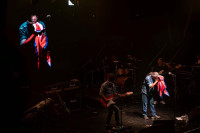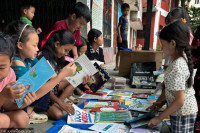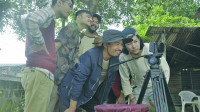Entertainment
Nepal at the India Art Fair in 2018
In Nepal’s third year at the prestigious and now very healthily populated India Art Fair (happening in Delhi from February 9-12, 2018), the Nepal Art Council (NAC) will be taking the works of seven very different artists who will be displayed at the Nepal Booth in the “Platform” section.
Sophia L Pandé
In Nepal’s third year at the prestigious and now very healthily populated India Art Fair (happening in Delhi from February 9-12, 2018), the Nepal Art Council (NAC) will be taking the works of seven very different artists who will be displayed at the Nepal Booth in the “Platform” section. The India Art Fair is now a showcase for hundreds of artists from across the subcontinent, but also around the world.
Part of making art is to be represented and to be seen, however, artists regardless of their audience must stay true to themselves and their chosen form. Six of the seven artists representing Nepal at the fair are either painters or draughtswomen primarily, choosing the traditional medium of drawing or painting—albeit to represent weighty but not so orthodox subjects which are closest to their hearts.
Sabita Dangol uses bright colours in her paintings to underscore the very feminine, domestic, and not so domestic concerns of her also female subjects. Unabashedly folky, bright, and picturesque, her work has a modern edge to a sensibility that can be seen as traditional (the Maithali fish motif, among others is painted by women on the walls of homes, and other auspicious and sacred sites) but is actually quite contemporary, with direct feminine gazes looking out at the viewer even as the surrounding imagery is representational of hearth and home.
Sujan Dangol, another very fine hand with a pencil, pen, or brush blows the mind with his highly detailed triptych of three Nepali men of different generations, with each panel of the triptych as a portrait of the wants, needs, and thoughts of the particular generation they represent. This is a prodigious work, full of whimsy, worry, and delight, two of the younger portraits beam out at the viewer, but the portrait of the old man with the broken spectacles is perhaps the most poignant, giving a necessary weight to the triptych—allowing it a narrative arc. With the work of both Dangols who so faithfully epitomise the concerns of their own gender, one cannot help but wonder what these talented artists might produce should they ever step into the minds of the opposite or third gender, for the sake of art and of evolution.
Sunita Maharjan is present on behalf of the many Nepali artists who do not work in the traditional figurative medium. Her series of stitched together fabrics representing the landscapes of Mustang are inspired from when she was recently conducting a workshop in that beautiful, arid, unspeakably dreamlike, almost foreign region of Nepal. While the work is interesting, unconventional, and indeed necessary as counterpoint to the other artists who will be on show (the Platform section is so that emerging artists are given their due space alongside the greats), these fabric collages are perhaps not yet at the point where the artist’s vision is fully realised in the chosen medium itself—a challenge that every artist must struggle with before finding their own form or forms. Her landscapes are flat instead of three dimensional, mainly because she is using a medium that is perhaps not the ideal one for such a venture.
Chirag Bangdel, now reaching the status of a senior artist himself, is represented this year, much to the delight of many of his fans. While sometimes repetitive, recurring variation in an artist of worth is not necessarily pejorative.
Bangdel’s painted canvases, highly stylistic and often fable like, depict men and women in profile, flying through the air, in front of confounding, beautiful landscapes, or sometimes just sitting and being in settings that frame the figures—lending them mystery and gravity.
With the decision to take the work of Jeevan Rajopadhya, a senior artist who paints in the manner of Kiran Manandhar and Laxman Shrestha, the two great abstract expressionists of Nepal, the NAC is making sure of its viewership in the older generation of viewers who prefer the paradox of these almost traditional, beautifully coloured, misty compositions that appeal to sensibilities that may not be moved by a finely detailed, highly composed, stitched landscape or a bizarre but charming spectacle of a fish with a comb. The blues hues of Rajopadhya’s work are admittedly stunning, but the formality of his work may not coalesce with the pieces of the other chosen oeuvre; it is brave and necessary that Swosti Kayastha, the curator (who has staunchly and surely stepped into the gaping hole left by the late Dina Bangdel), and Sagar Shumsher Rana, Vice Chairman of the NAC board, have helped to choose (the entire NAC board was involved in the final choice) a diverse group that will represent a wide range of the artists who now live and work in Nepal.
Rabindra Shrestha’s work is admittedly perhaps one of the most remarkable in this show, his poignant large scale earthquake line series speaks to the heart of the Nepali tradition and psyche, representing all that broke and is still yet to fix, more than two and half years on. In contrast, with the highly conceptual finger print series, representing all that connects us as human beings.
This artist shows his range and his ability to flip the same subject and apply it to two very different mediums.
Mekh Limbu—an artist concerned with the plight of the immigrant workers (his father left his family to work abroad when Mekh was a little boy) is represented by his acrylic paint comic strip—a searing depiction of the life of a Nepali migrant worker, his troubles, travails, desires and loves as he struggles abroad—a work that was also recognised and on show in the Kathmandu Triennale earlier this year.
With this wide range of Nepali voices, it would be strange if the booth did not do as well as it has the past years, where works have flown off the shelves, so to speak—the India Art Fair, unlike an art festival, is commercial, with shareholders and stakes, even while it also promotes a more traditional education and platform oriented show like the Dhaka Art Summit. But art is and must also be commerce for the artists and art promoters to make a living. This is another opportunity for our contemporary artists to be seen, heard, and discussed on an international platform like the India Art Fair where galleries and museums across the world are represented and visit to see what’s on show, and, what’s for sale.




 9.12°C Kathmandu
9.12°C Kathmandu










